Top 10 NFT Marketplaces
2021 may be seen in the future as a pivotal year in the history of art. Historians could look back and point to 2021 as the year when...
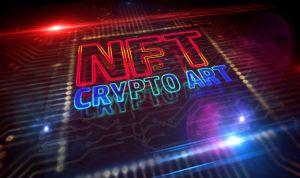
2021 may be seen in the future as a pivotal year in the history of art. Historians could look back and point to 2021 as the year when NFTs exploded onto the world stage. NFTs are beginning to command staggering amounts of wealth. In January 2021, the total NFT sales for 6 major marketplaces tracked by cryptoart.io amounted to just shy of USD 12 million. By March 2021, this had ballooned to over USD 200 million. That’s a sixteen-fold increase in two months. The scary part about all of this: NFTs are still a young space in the decentralized ecosystem. Bitcoin was born in 2009. NFTs have only been accessible since 2017.

Having said all of that, which are the top NFT marketplaces out right now?
There is no right answer for this. The space is so new that the marketplaces are experimenting with how to present their NFTs best. Instead of a clear hierarchy, consider that this list of top NFT marketplaces contains some of the biggest marketplaces and the pros and cons of each. So although these marketplaces will be evaluated for their own particular qualities, these marketplaces have been chosen for their user base and monetary volume. In other words, these were chosen with mostly objective metrics but were evaluated subjectively.
We’ll divide the ten marketplaces chosen here into four categories:
- Open marketplaces
- Curated marketplaces
- Collectibles marketplaces
- Games marketplaces
The open marketplaces are ones where you can find anything under the sun, from visual art to music files, to collectibles, to game items. In this way, these NFT marketplaces are more open to any person who wants to enter the NFT space. Collectibles are sets of NFTs that are all branded with a similar quality, like CryptoPunks, for example. The collectible marketplace for CryptoPunks is all made in the same style, but they have varied faces and colors. The games marketplaces section will include NFT marketplaces that are motivated by assets bought on gaming applications.
Open Marketplace NFTs
1. OpenSea

OpenSea is often considered the first NFT marketplace and claims to be the biggest NFT marketplace out there right now. DappRadar analytics agrees. As far as general marketplaces go, OpenSea has had the most monetary volume in the last 30 days, or the month of March 2021.
The interface is calming to use as the white background and blue make the links pleasant to engage in. For being perhaps the oldest open marketplace around, the user interface is surprisingly intuitive. OpenSea should also be considered good for beginners to get started on because the tutorials they give are easy to understand. Yyou can learn a lot about how the NFT marketplaces work by using the platform.
Minting an NFT collection doesn’t require you to pay gas fees (transaction fees) every time you mint an NFT. Instead, it’ll prompt you to pay a one-time gas fee once you begin selling on the platform. The buyer has to pay the gas fees when buying your art.
The royalties you can get per item, however, aren’t as high as a platform like rarible, as it’s capped at 10%, while rarible’s royalties you can post for as high as 30%. Although, that may not be a bad thing since a prospective investor might have a hard time wanting to sell your work if the royalties are too high.
Also, you can add items from other platforms like Mintable and Rarible to OpenSea, making it truly an “open sea” in that regard.
2. Rarible

For an open marketplace, they have the highest amount of users by far and for a good reason. When you type in the URL for Rarible, you’re instantly greeted with the marketplace. Compare this to OpenSea, where you have to click the explore button to see what’s bidding. The user interface on Rarible is Pop-like and gives a fun atmosphere. The yellow theme accentuates this and makes the platform look fast, busy, and easy-going. It doesn't take itself super seriously.
You’re also shown the top sellers of the day and some advertised NFT prospects at the top, making it simple to engage with the marketplace immediately. This marketability is probably a big reason why the user base is so high. That and you see occasional celebrities like Mark Cuban and Lindsey Lohan was thrown into the mix. It makes the NFT space comforting to the average user. It’s less about being at the cutting edge of the art technology and more about light-hearted engagement with a community of artists.
Minting NFTs on the platform, however, does require gas upfront. If you’re starting, this could be incredibly costly. Just for transactions alone, you’re looking at USD 100 worth of ETH on a busy day. On the flip side, you can set your royalties really high, up to 30%. If you feel confident that the value of your NFT will remain high even with high royalties, then this could be how you want to mint your NFTs.
Curated Marketplaces
3. Foundation

Foundation is not your average curated marketplace. On Foundation, the community votes for the artworks that will appear on the application, making it more peer-to-peer, like the technology that NFTs are founded on. To apply to become an artist, you have to create an account and add your name to the Community Upvote. After this, your fate will be decided on how the community votes on your art. If you want to vote once you’re a verified member, you log in, check out the creator list, and then give support to the artists you prefer. Foundation aims to put “power in the hands of creators.” As of now, it’s not completely user-curated, but it aims to be fully peer-to-peer once the community grows. Although its user base is still growing, it has a really high monetary volume.
The user interface is black and futuristic. The images are large, clear, and professional. The top-left corner has black, solid shapes: a triangle, circle, square. Underneath each NFT up for bidding is a solid black bar, with each auctioned NFT spaced apart well. The minimalist, black aesthetic definitely makes the platform look cutting-edge and professional.
One possible drawback of a purely user-curated platform is that there could be a dominant style that pervades the space if all the users are on board. It could hamper the diversification of the platform. Then again, you could argue that this quality will help Foundation solidify a concrete, thematic style.
4. SuperRare
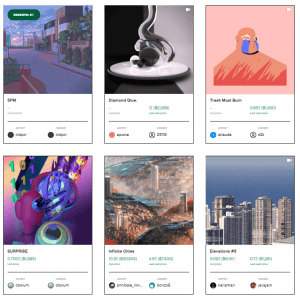
Founded in 2017, the originally curated marketplace, SuperRare lives up to its name. Each artwork is one of a kind. This means that the art you see has no minted copy. Hence: ‘super rare.’ The platform is marketed as a mix of Christie’s, the famous high-end auction house, and Instagram. In a sense, they do achieve this aura, which has a lot to do with their top-notch editorial. There, we get a sneak peek of the artists, their styles, acclaim, and stories. This editorial gives a strong, ‘high end’ presence to the platform.
Instead of a community vote, an artist must send their work to be submitted, and the SuperRare staff will decide if they belong to be sold. This makes the average quality of the art really high. Their ethos revolves around the love of collecting. SuperRare believes in collecting as a social act that users will participate in, and this shared fascination bonds the community. The gallery receives 15% of the commission of a first sale, while the artist receives 85%. From then on, the original artist receives 3% of the royalties.
SuperRare uses a minimal, professional-looking interface. Even so, it doesn’t look quite as clean as Foundation. The name SuperRare also doesn’t sound as high-end as Foundation either. SuperRare is ‘stating-the-obvious’ whereas the word Foundation gives a universal feel. Despite this, SuperRare provides a good case as a cryptographic Christie’s with the artworks’ rarity and reputation. The mentioned editorial does wonders to elevate SuperRare’s image.
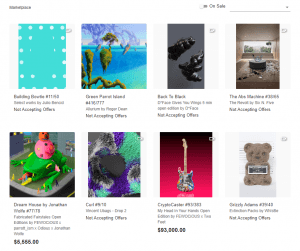
As the crypto art chart at the top of the article has shown, Nifty Gateway commands the most impressive sales numbers from all the curated art marketplaces. Boasting big names like Steve Aoki, Calvin Harris, Grimes, and The Weeknd, Nifty Gateway truly has impressive names auctioning off their art.
What makes Nifty Gateway such a huge force in the NFT world? Simple. You’re able to pay with a credit card. Users don’t have to set up a Metamask and pay with Ethereum, making it more relatable. The platform does the work of bringing centralized processes to decentralized processes for you. In this way, Nifty Gateway bridges the gap between the larger population and the decentralized world. Their mission is to bring NFTs to a billion people.
Those who wish for a purer decentralized world, however, may not like the idea of such a huge marketplace for NFTs selling artwork with a credit card. This gives owning something on a decentralized network a contradictory feel. And although their platform hosts some of the big-name artists, it isn’t as much of a “high-end” feel, with just the simple design of white space between each NFT. Still, Nifty Gateway is an inspiring platform and has done a lot to thrust NFTs into mainstream consciousness.
Marketplaces for Collectibles
6. CryptoPunks

With only 10,000 of these available, CryptoPunks are still some of the most valuable NFTs around. Founded by LarvaLabs, these simple, pixelated portraits are valuable for their origin: some of the first NFTs available on the Ethereum blockchain. There are only nine rare ‘alien punks.’ These editions were originally sold for less than USD 100. Four years later, they’re worth up to millions.
The website isn’t the most varied in terms of what you can buy, but the site has a defined pink-violet color scheme. Although you can find some of these CryptoPunks on OpenSea, they are neatly laid out on larvalabs.com. The thing is, just by virtue of them being a revolutionary point of blockchain history, this deserves a spot as one of the top marketplaces in the world.
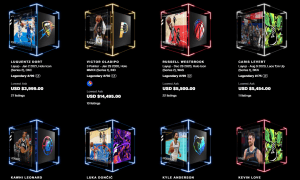
Although relatively new, NBA top shot is already one of the most financially successful NFT marketplaces out there, boasting over 340,000 users. According to DappRadar, NBA Top Shot has already earned over USD 180 million in the past month. By comparison, Cryptopunks has had a monetary volume of around USD 250 million. NBA Top shot only came out in late 2020. CryptoPunks has been around since 2017!
Visually, the aesthetic is far more advanced than the CryptoPunk feel, the collectibles being 3D highlight reels of NBA moments. Dapper Labs has done stunning designs that really look like the future of NFT collectibles. The only knock on it would be for decentralization purists who don’t believe you should be buying them with fiat currency. Otherwise, the layout and presentation are something you’d expect from one of the biggest sports in the world.
8. Ether Cards
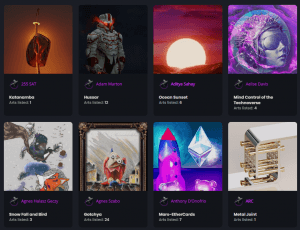
Straddling the line between art and card collectible, Ether Cards is highly original. The platform is curated by the Ether Cards team, and the quality of artists they have is top-notch. Artists can customize their artwork into trading cards with their own unique qualities, ‘gamified’ according to EtherCards. The design of the website is sleek and professional, rivaling anything out on the market right now.
Each of the artists have well-written bios that explain their work, elaborating their vision well. They also put an extra emphasis on collecting entire sets from an owner. Each card you own will have its own qualities attached to it. You may unlock different ones depending on what you get. You can also obtain bonuses if you have entire sets of cards. Although the platform is not as accessible to those who aren’t already interested in NFTs, the platform has provided unique, innovative ideas for the NFT space.
Games Marketplaces
9. Axie Infinity

If you like strategy games and cute creatures, Axie Infinity will be your cup of tea. In it, you can create a team of monsters, or Axie, to battle other monsters using your collected Axie cards. You can even breed your own monsters to create a new Axie. Once you're comfortable with the mechanics, you can use your cuddly creatures to battle other players.
On the marketplace, Axie monsters, items, plots of game land are put up for auction. The cuteness of the platform is inviting to those who aren’t normally interested in the decentralized world. The large buttons and inviting design make the interface easy to get into. Boasting healthy sales volume and user base, Axie Infinity has established itself as a prominent game and NFT marketplace.

Although some might take issue with calling Decentraland a game, its virtual reality world is very much like a sandbox video game. In a sandbox game like Minecraft, you are given a set of tools and rules to construct the world to your imagination. In Decentraland, you can buy plots of digital NFT land and build whatever you want on them. Some players have built museums that host their NFT art, put games in their land, or even create markets on them. A few users have also made tons of money buying parcels of digital land to sell them off later. Yes, digital real estate flipping is a thing now.
You might ask, ‘how on earth digital land can be so valuable’? Every time a user plunges into this virtual world, the user is automatically engaged and interacting. If a company is advertising on it, you can enter their virtual building from anywhere in the world and interact. There will be features in which you can click on billboard advertisements, and you’ll be redirected to the advertiser’s website. This is arguably a more engaging advertisement than passing by a huge physical billboard in the real world. The options are only limited by creativity.
That said, it’s a fairly complicated platform, so it might be hard for those who aren’t used to sandbox-style worlds. However, users will be satisfied that they create the world, and the possibilities are endless.
